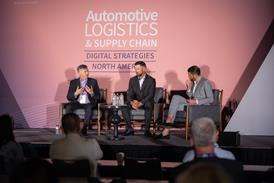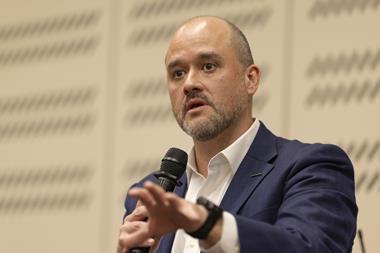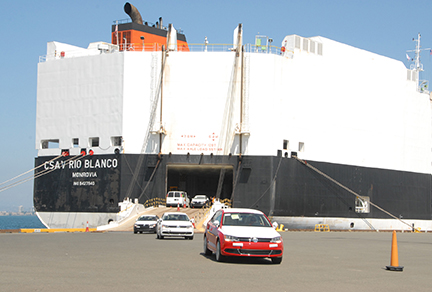 Although rail continues to be the dominant mode to move vehicles from Mexico to the US, short-sea shipping is becoming ever more viable.
Although rail continues to be the dominant mode to move vehicles from Mexico to the US, short-sea shipping is becoming ever more viable.
Short-sea shipping for Mexican vehicle exports to the US isn’t new. It’s been around for decades, but every few years it pops up as an ‘emerging trend’. In the 1990s, for example, during a time of rail strikes and capacity issues in Mexico, talk turned to the potential of short sea. Similarly, in 2005, high sales in the US and rising production in Mexico led shipping lines and OEMs back to using more short-sea options. And for the past few years, as Mexico’s production and export boom has become increasingly apparent, the prospect of regular or even dedicated short-sea services is once again a hot topic.
Is anything different this time? Rail remains by far the dominant route for exports today heading north from Mexico. However, with the scale of Mexico’s production and export growth, there are certainly more vehicles moving by vessel from Mexico northbound than there have been before, with several carmakers allocating a portion of their export volume to the mode. A number of shipping lines and port operators have clear ambitions to increase short sea – and OEMs seem open to the idea.
In this story...
In 2013-2014, according to statistics from Wallenius Wilhelmsen Logistics (WWL), around 80% of exports went by rail to the US and Canada, with the remainder by sea. However, for 2015, figures compiled by the Mexican carmaker’s association, AMIA, suggest the proportion of short-sea volume is between 25-30%, depending on the time of year and demand peaks. That would suggest short-sea services are increasing faster than exports are rising.
In the past, short sea has struggled to maintain momentum against the railways, which have a relatively higher frequency. If a plant is near or attached to a rail yard, for example, cars can be exported to the US almost every day. Nearly all short-sea services within North America, by contrast, are port calls that are part of larger trade routes, rather than the dedicated loops that are common in Europe. In that context, carmakers might expect just a few sailings per month, although this number appears to be rising.
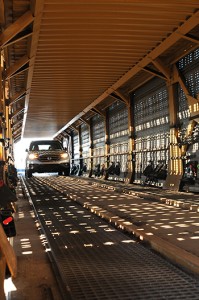
An increase in production and exports is prompting shipping lines to consider increasing their options. Over the next few years, for example, production is set to rise by at least 1.5m units to 5m as Audi, Kia, Mercedes-Benz, Infiniti, BMW and Toyota add new plants in Mexico, while others, such as GM, plan big expansions. This investment will lead to higher exports to the US and Canada, which are already at record levels: in the first ten months of 2015, export figures from Mexico to the rest of North America stood at more than 2.1m units, up 5.4% compared to the same time frame last year in 2014.
While executives at shipping lines are not ready to commit to firm plans, companies such as Höegh Autoliners are exploring new options, including the potential for dedicated loops. Executives at US-based ports also predict that such services will rise – provided OEMs are willing to commit more volume to short sea.
More than a fall back?Despite growing volumes, short sea is still seen as a last resort in many cases, according to Frank Camp, director of non-containerised cargo at Jaxport, at the port of Jacksonville, Florida. In some cases, it may be tied to equipment shortages, though more often it is a function of lead time, he says. “Many OEM plants are serviced by daily trains taking vehicles north so they can move cars much faster to market via rail than by short sea today,” he says.
On the other hand Bill Kerrigan, a long-time shipping veteran and consultant who recently took over as vice-president of logistics at SSA Marine, believes that short-sea shipping is becoming a more integral part of OEMs’ supply chains. Carmaker executives also agree that a healthy mix of rail and short sea is best.
“Short sea can be an effective part of an overall transportation network. We would like to see a higher frequency of short-sea shipments and port options,” says Lee Hobgood, vehicle transportation operations corporate manager at Toyota Logistics Services, which is responsible for vehicle logistics in North America at Toyota.
Toyota, which recently starting building vehicles at Mazda’s plant in central Mexico, has added short-sea routes alongside its use of rail. “Short sea is currently a component of Toyota’s transportation network for Toyota/Scion vehicles built at the joint-venture plant with Mazda in Salamanca,” adds Hobgood. “We currently ship finished vehicles from Veracruz and Lázaro ports in Mexico to Long Beach, Newark, and San Juan [Puerto Rico].”
Short-sea shipping is now a viable option for OEMs, argues Don Asdell, vice-president and chief commercial operator at International Auto Processing (IAP), a terminal operator and processor at the port of Brunswick, Georgia. “OEMs do and will look at short sea to complement their rail and truck networks,” he says.Going further, Per Folkesson, president and head of region Americas at Höegh Autoliners, predicts that within a year short-sea shipping will transition into a regular mode of transport, with a firmer commitment to volume from shipping lines and carmakers.
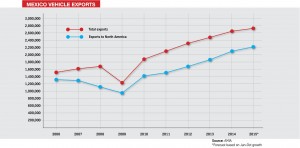 Click to enlarge
Click to enlargeReasons to diversify transportMany shipping and port executives in the US suggest that a lack of capacity for rail will lead more volume to short sea as exports rise. Greg Lovelace, director of marketing and business development, cargo and cruise, at Port Tampa Bay in Florida, says, “As the volume of vehicles increases, the traditional distribution channels to the US will become further strained and new options, such as short-sea shipping, will become a viable supply chain solution for OEMs to deliver vehicles in a timely manner.”
So far, however, there has not been a big shift away from rail. Automotive rail services out of Mexico have seen some capacity issues, and there are infrastructure deficits in places – particularly for rail lines going through cities – however the disruptions have in many ways been less severe than what was seen in the US and Canada in recent winters. Meanwhile, railway companies in Mexico, including Ferromex and Kansas City Southern de Mexico (KCSM), have made significant investments in both railcars and infrastructure to try to secure capacity for future growth.
Nevertheless, the sheer volume of exports out of Mexico suggests that more services by sea will be required. Antonio Zepeda Torres, director of commercial for Grupo CSI, a logistics provider and terminal operator in Mexico, thinks the shortage of railcars will become more frequent, and Bill Kerrigan adds that OEMs are already experiencing significant restrictions, with some only able to load 30 out of a possible 60 per day.
There are other well-documented issues in moving vehicles by rail in Mexico, which lead some carmakers to diversify their shipping options. “Vandalism is a known challenge with rail shipments when vehicles must dwell at interchanges,” says Lee Hobgood. “As the transportation infrastructure develops, we hope to continue to explore different shipping options out of Mexico.”
Tom Hosaka, vice-president of the ro-ro division for NYK Line, which offers connections between Mexico and the US, also points to security issues. “We hear that theft during rail and during connections is a big problem for our customers,”he says.
Current and future short-sea movementsWhile short sea-services cannot generally match the frequency of rail, they are becoming more of a regular service out of Mexico. For example, several shipping lines, including MOL Ace, offer services with connections between Veracruz and Brunswick as frequently as once per week. Hosaka at NYK Line says his company already has a twice-monthly regular service exporting from Veracruz to the east coast, and a once- or twice-monthly service exporting from Lázaro Cárdenas to the west coast for various OEMs. Per Folkesson adds that Höegh offers up to five sailings per month from Mexico to the US between its deep-sea vessels calling at Mexican ports en route to the US.
Ports including Brunswick and Jacksonville report higher levels of imports from Mexico. In the last fiscal year, volumes from Mexico represented around 10% of the overall Jaxport automotive business, and Frank Camp says there are now a number of short-sea services arriving at Jacksonville monthly from Mexico.
Another development is the rising popularity of shipping from Mexico to the US west coast. Short sea has always been more common to the east coast, according to Bill Kerrigan. He points out that ships coming in from Asia go through the Panama Canal, and then it’s just a case of adding a few stops in Mexico on the way up the east coast.
“On the west coast, it is a little bit crazier,” he says. Ships moving westbound around the world to the US west coast are less frequent compared to eastbound from Asia, plus stopping in Mexico and routing up the west coast adds lead time.
However, a number of carmakers are increasingly using ports like Lázaro Cárdenas on Mexico’s west coast, where Amports and SSA both have terminals. Honda set something of a precedent with its regular use of Lázaro to export to the west coast from its new plant in Celaya. This past November, Ford shipped its first exports from the port with vehicles destined for Portland, Oregon. Toyota is also using the port to ship to Long Beach.
 "Short sea can be an effective part of an overall transportation network. We would like to see a higher frequency of short-sea shipments and port options."
"Short sea can be an effective part of an overall transportation network. We would like to see a higher frequency of short-sea shipments and port options."
- Lee Hobgood, Toyota Logistics Services
US Gulf ports in Texas and Florida are also looking to nab potential new business from Mexico. Greg Lovelace from the port of Tampa Bay claims that using his port would save 2.5 days in transit time to reach the local market there compared to other east coast ports.
Höegh has recently opened a new terminal at the port of Freeport, Texas, which it believes could eventually play a role in US-Mexico short-sea trade. WWL, meanwhile, is opening a terminal in Galveston, Texas, for BMW imports, but which could also eventually be an entry point for Mexico.
For Toyota, which will build a new factory in the state of Guanajuato by 2019, Hobgood sees short sea as a viable option for covering a significant geography across North America, and he leaves open the possibility that the mode would factor into future export routes. “Interest among ocean transportation providers is clearly increasing and, with investment in infrastructure and a greater frequency of vessel shipments, we would expect that the opportunities to utilise this mode of transportation could increase as well,” he reveals. “We routinely re-evaluate our transportation infrastructure and make changes based on quality, security, service and cost effectiveness.”
The need to act nowExports to North America account for about 91% of total exports from Mexico, and that number has been growing steadily as new plants come online. However, several issues have prevented volume moving northbound by short sea amidst this expansion. For example, the country’s largest port, Veracruz, on the Gulf coast, saw declines in its vehicle handling from more than 800,000 units in 2012 to around 680,000 in 2014, falling even as the country’s exports rose. Fewer exports from Volkswagen played a role, but so too did capacity issues and constraints. Currently, Veracruz is not able to berth the larger, post-Panamax vessels that are becoming more common, for example.
Executives at carmakers also point to security concerns at ports, as well as poor paving at terminals. At Toyota Logistics Services, Hobgood says there is a need for more secure vehicle processing facilities to ensure quality and efficient operations, as well as better inland access.
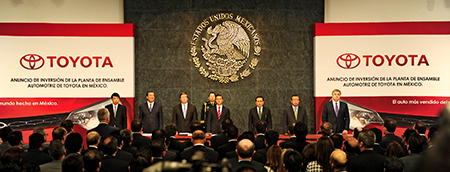 Toyota has started building vehicles at Mazda's plant in central Mexico, while its new factory, which will be up and running in the state of Guanajuato by 2019, might also use both rail and short-sea routes
Toyota has started building vehicles at Mazda's plant in central Mexico, while its new factory, which will be up and running in the state of Guanajuato by 2019, might also use both rail and short-sea routesThere are plans to improve infrastructure at Veracruz, but there are concerns over the timeline, including a new ro-ro terminal that could be built as late as 2030. “In Veracruz, the government is talking about expanding the port, but the likely time horizon for this is very long and expansion is needed faster,” says Per Folkesson at Höegh. “It will likely be investments done by both the government and the private sector between the various ports.”
Antonio Torres at Grupo CSI, however, is encouraged by plans to expand berthing capacity at Veracruz in terms of the number of ships and the maximum lengths.There has been development at other ports in Mexico as well, including Lázaro Cárdenas, where volume rose by 22% in 2014 to nearly 305,000 units, with 2015 figures expected to be higher.
Potential exists at a number of other locations, including Tuxpan, Altamira and Tampico. Bill Jakubsen, global manager ro-ro, bulk and general cargo at Georgia Ports Authority, points to significant investment plans by the Mexican government. “Mexico’s transport and communications ministry is developing 25 port projects across [the country] and they will have an investment of more than $4.1 billion. It is my understanding they will convert the ports of Tuxpan and Veracruz into strategic ports for vehicles,” he says.
However, even if billions are to be poured into ports, the success of ocean-going exports out of Mexico will ironically also be dependent on rail links, namely from car plants to port terminals. Jakubsen points to poor connections for road and rail to the ports of Veracruz, Tuxpan, Altamira and Tampico. At Veracruz, for example, there are issues with rail access to the port as the main line cuts through the city, limiting speed.
“Additional port options for finished vehicles and the transportation infrastructure to ship vehicles to those outbound ports is needed, too,” says Lee Hobgood.
Closing the loopThe question for many is whether or not shipping lines will expand services to include shuttles between the US and Mexico. While exports from Mexico are increasing, a lack of traffic from the US to Mexico, as well as the need for smaller, dedicated vessels, are both points against such services. Bill Kerrigan at SSA Marine suggests that such ‘closed-loop routes’, which have been attempted before, remain unlikely.
“It would be nice, but it’s not a reality. It’s a huge investment to build these vessels,” he says. “If we could take a bunch of 1,000-car vessels like those [short-sea operator] UECC runs in Europe, it would be good, but I just don’t think at this point it’s an investment shipping lines will make.”
Executives at shipping lines are certainly tempted, but many agree with Kerrigan’s assessment – at least for now. Rich Heintzelman, EVP and head of commercial, WWL Americas, says that WWL has put on services from Veracruz to the Gulf and southeast markets in the US based on opportunities presented, but as future volume becomes more predictable, more ocean products will develop. Currently, most ‘short sea shipping services’ are in fact deep sea. “The capital costs associated with providing these services are more reflective of deep sea services, while the volumes have been small… This is challenging for ocean carriers, but should become easier to manage as time goes on,” he says.
 While investment is required in infrastructure at many Mexican ports, the success of short-sea shipping would also partly rely on improved rail and road connections between plants and port terminals
While investment is required in infrastructure at many Mexican ports, the success of short-sea shipping would also partly rely on improved rail and road connections between plants and port terminalsAt Höegh, however, Per Folkesson says the shipping line already has ships of the right size to trade in short-sea and regional patterns. Höegh’s chief executive officer, Ingar Skiaker, has revealed the company is actively considering a short-sea offering with dedicated vessels. However, Folkesson acknowledges that the end result will come down to having some balance of north- and southbound trade. “The question will always be whether these can trade economically between Mexico and the US,for example. There is basically a need to have return cargo.”
At Jaxport, Frank Camp agrees that a lack of sufficient southbound volume is hampering dedicated loop services. However, port executives suggest that such services would be viable if OEMs committed enough volume to them, which would allow both shipping lines and port operators to invest in the right capacity.
“To invest in additional property, processors need a commitment from the OEMs,” says Don Asdell at IAP. “As lower volumes will not justify port calls, OEM volumes need to be consolidated at the port of exit and port of entry to produce acceptable frequency and service.”
Not such a slam dunk for rail or seaFor many players in the US, there is no question that short sea is going to increase. Jakubsen and Asdell out of Brunswick both believe short sea will become a regular mode to both the east and west coast. Evan Matthews, port director at the port of Davisville, Rhode Island, a US entry port for the Volkswagen Group, also anticipates more growth from Mexico. “I am very optimistic and preparing for sustained growth,” he says.
As production increases, and capacity on rail and truck tightens, short sea will become more appealing, says Frank Camp. “Despite old and constrained infrastructure at Mexican ports, I believe we will see continued growth in the short-sea movement of vehicles to the US,” he says. “Organic growth from increased production and OEM fatigue due to the rail issues that surface periodically will contribute to this growth. I predict that short sea will continue to be a fierce competitor for vehicle movements to the US.”
At Höegh, Per Folkesson says the outlook for short sea is good, but he emphasises that the industry and OEMs need to commit to supporting its development. “Development of land-side capacity and systems will likely happen in phases, but in the end we have to make it work,” he says.
Bill Kerrigan also thinks ocean volumes will grow, but that won’t solve the problems of congestion, port berth and dwell time currently hampering Mexican ports. Meanwhile, Hosaka at NYK Line agrees that short sea will be a stable option, however he believes that rail will still be the primary means of export out of Mexico northbound.
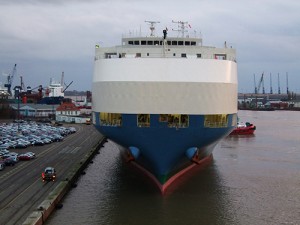 Rail will remain dominant for the forseeable future but there is little doubt that the use of short-sea will grow as production in Mexico rises over the coming years
Rail will remain dominant for the forseeable future but there is little doubt that the use of short-sea will grow as production in Mexico rises over the coming yearsWhile rail is almost certain to remain dominant for the foreseeable future, the expected expansion of Mexican production makes it likely that short-sea shipping will grow with the increasing output, both from existing players, and new ones. For example, at the FVL North America conference last year, Glenn Clift, president of Glovis America, a subsidiary of Hyundai Glovis and the Hyundai Motor Group, revealed Glovis’s shipping arm was considering an ocean connection out of Mexico to the US, especially as Kia prepares to open its new Mexico plant.
Scott Cornell, vice-president for ocean carrier at Hyundai Glovis, though unable to comment on current plans, nevertheless sees a bright future for shipping out of Mexico, where rail and sea will be essential – and where the decision over which mode to use won’t be quite as obvious as it might still be today.
“The future will see a split between ocean and rail, and the percentile split amounts will continue to fluctuate due to the capability of either industry segment to invest or, just as importantly, coordinate the proper and efficient assets needed,” Cornell says. “It will no longer be a slam dunk in favour of rail for frequency and transit time.”



























